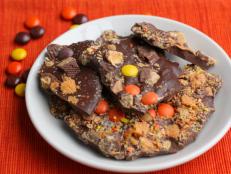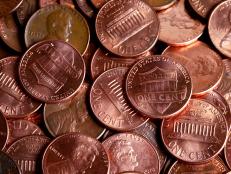Nostalgic, Old-Fashioned and Retro Candy and Candy Bars
Take a sweet trip down memory lane by ogling these old-school candy bars and confections.
100 Grand
You'll feel like you’ve hit the jackpot after sinking your teeth into this milk chocolate treat with the perfect chewy-crispy ratio of caramel to rice crunchies.
Abba-Zaba
Whether you travel west of the Rockies (where they're generally sold) or order them in bulk online, you may want to revisit these peanut butter-filled taffy bars. They're delicious.
Bazooka
Bazooka isn’t the best gum overall. But it is the best bubble gum that comes with a comic strip, a fortune and the promise of a "Secret Club Ring" if you mail in several hundred wrappers. (If only that ring could then pay your dentist bill.)
Big Cherry
These individually packaged balls of milk chocolate goodness are sprinkled with salty chopped peanuts and filled with a pink, sugary goo and maraschino cherry.
Big Hunk
These thin (but substantial) candy bars give sweet (if boring) nougat the pizzazz to make a standout candy bar: honey-sweetened, roasted peanut chunks.
Bit-O-Honey
When this almond-filled, honey-flavored taffy first hit candy shelves back in 1924, it was the first of its kind, split into 6 pieces and wrapped in wax paper.
Bottle Caps
That eccentric Willy Wonka has his Oompa-Loompas making sugary, tart soda-flavored candies in the likeness of metal soda bottle caps. Good luck topping that, Slugworth.
Bun Vanilla & Roasted Peanuts
Don't be fooled by this candy's unassuming shape: Roasted peanuts, milk chocolate and a creamy vanilla center make for a scrumptious treat.
Charleston Chew
One bite of the nougat-filled chocolate will have you doing a happy dance, making the name of this delicious candy well-founded.
Chick-O-Stick
Named based on a whim of its creator, this peanut butter-and-coconut round, brittle stick is much more mild-flavored than its bright orange hue would imply.
Chuckles
This vintage jelly candy which hit the market in 1921 comes in five flavors: cherry, lemon, lime, licorice, and “zesty orange,” each coated in a dusting of granulated sugar. We concur with the old Chuckles slogan: “Purest candy tastes just dandy, keep it handy.”
Chunky
"Chunky, what a chunk of chocolate!" proclaimed the slogan of this 1930s-era trapezoidal milk chocolate bar, chock-full of peanuts and raisins. Legend has it that the original shape was a pyramid, but due to packaging difficulties, the top was chopped off.
Candy Cigarettes
These pure sugar candy sticks were pretty easy to love (even if they set a really bad example for children). Bearing an uncanny resemblance to the real thing, they allowed us all to channel our inner James Dean.
Clark
This predecessor to the Butterfinger bar features a peanut butter crunch covered in milk chocolate.
Crows Licorice Flavored Gumdrops
These tasty black licorice-flavored gumdrops entered the scene in the 1890s and have been a sweet favorite ever since. If you're wondering about the name, the printer misheard the originally intended name "Black Rose" and put "Black Crows" on the wrappers.
Cup-O-Gold
This cup of gold is made out of milk chocolate, almonds and coconut with a gooey marshmallow interior.
Original Dubble Bubble
As the package proclaims, this classic bubble gum has been around since 1928. When first introduced, it came wrapped in a comic strip featuring twin brothers Dub and Bub.
Good & Plenty
These small licorice-flavored, candy-coated capsules are one of the oldest candies in the United States, having been introduced in 1893.
Good News
Rich milk chocolate, peanuts and caramel: Everything about this bar is good news! No wonder it’s a big favorite in Hawaii.
Hershey's Milk Chocolate
The milk chocolate bar with an entire amusement park dedicated to its history is hardly mere vintage kitsch. The first bar appeared in 1900, though this packaging hails from the 1920s.
Hershey's Milk Chocolate With Almonds
There's only one way to make this classic milk chocolate bar better: add lots of almonds.
Idaho Spud
Sorry folks, there is no potato in this candy (although that’s probably a good thing). With light cocoa-flavored marshmallow drenched in dark chocolate and sprinkled with coconut flakes, it's one of the top-selling candy bars in the Northwest.
Jujyfruits
Since its creation in 1920, this gumdrop-like candy has been packaged in a bright yellow box with big bubble letters, simple illustrations and the jolly slogan, “Chewy Fruity Candy!” Chewy indeed: Try tearing your way through a box of the fruit- and vegetable*-shaped gummies without ending up with half of them still stuck in your teeth. (*That’s right: Did you know the lime-flavored candy is actually in the shape of an asparagus bundle?)
Look!
Anyone with an ounce of curiosity would be compelled to peel back the wrapper of this bold chocolate-covered peanut nougat bar, produced by California-based Annabelle Candy Company since 1978.
Mallo Cup
In the late 1930s, candy-making brothers Bill and Bob Boyer introduced the Mallo Cup: a chocolate cup with a whipped marshmallow creme center. This cross between Mallomars and Reese's Peanut Butter Cups is a can't-miss treat.
Mountain Bar
Inside Mountain Bar's simple striped wrapper you'll find a mount of chopped peanuts surrounding a vanilla, peanut butter or cherry filling.
Necco Wafers
First produced in 1847 and originally called "hub wafers," Necco Wafers were actually carried by Union troops during the Civil War. The wafers, which come stacked in rolls, come in eight flavors: lemon, lime, clove, cinnamon, orange, wintergreen, chocolate and licorice.
Nik-L-Nip
Bite the head off these small wax bottles to slurp down the sugary flavored juices inside. Like the candy cigarettes, we're not entirely sure what devious practices this early-20th-century confection is encouraging — but we like it.
Now & Later
As their name implies, when Now & Later candies were created in 1962, they were meant to be enjoyed in increments: some now, some later. (The time required to unwrap the candy’s complex packaging practically mandates that you break up the eating experience.) The chews, originally sold in red, green and purple-blue flavors, are much tougher than taffy, so it’s always better to suck on them for a bit before actually attempting to chew.
Oh Henry!
Whether this chocolate-covered peanut, caramel and fudge bar created in 1920 is named after American writer O. Henry or a boy who flirted with Williamson Candy Co.'s female workers remains a mystery.
PayDay
PayDay first came out in 1932 when a bar of caramel encrusted in salty peanuts may have cost an entire week’s salary for some.
Pop Rocks
In the 1970s, a small family-owned company shook the confectionery industry with its cherry- and grape-flavored exploding sugar crystal candy. The popular pouched rocks contain miniature high-pressure bubbles created during the candy’s heating process, which cause them to pop and sizzle when saliva releases the carbon dioxide. Pop Rocks were so revolutionary that rumors spread broadly that if a person ingested the candy and cola at the same time, their stomach would explode — an urban legend that persists among children today.
Razzles
Razzles are candies that turn into gum when you chew them, so you sort of get two candies for the price of one. To further the economic incentive, they notoriously change the color of your tongue, so they double as one of the world’s most affordable costumes.
Rocky Road
The fluffy marshmallow center contrasts nicely with the crunchy exterior of this candy bar, a "rocky road" of milk chocolate paved with loads of cashew nuts.
Rolo
The drums of milk chocolate with a caramel center have been around since 1937 — and it's no surprise they're equally as popular today.
Sky Bar
Can’t decide if you want a chocolate bar filled with caramel or a chocolate bar filled with vanilla? Or fudge? Or peanut butter? With the four-compartment Sky Bar you will get your fill of fillings.
Sugar Babies
Don't have time to down an entire Sugar Daddy caramel pop? These mini bite-sized candy-coated caramels will help you get that stick-to-your-teeth delicious satisfaction.
Sugar Daddy
Created in 1925 by a man named Robert Welch, the Sugar Daddy is a slow-cooked milk caramel pop in the shape of a long rectangle. Initially called a Papa Sucker, it was renamed in 1932 to suggest “a wealth of sweetness.” And let us tell you: It doesn’t get much sweeter than hardened caramel on a stick.
Sunkist Fruit Gems
When Sunkist Fruit Gems were first introduced more than 30 years ago, the colorful soft fruit candies were sold in packages of six lined single file on a cardboard tray. The sugar-coated gems were available in lemon, orange, grapefruit, lime and raspberry and contained a unique jelly-like center. Nowadays, lime has been nixed from the lineup for the sake of blueberry — a sad state of affairs to those of us who always hoped that their package of six would contain two greens.
Giant Chewy SweeTarts
Pucker up: Giant Chewy SweeTarts are full of intensely contrasting flavors. With the texture of a soft baked cookie but a sweet and sour flavor reminiscent of Sour Patch Kids, this candy packs a wallop of fun flavor.
Turkish Taffy
Not really taffy so much as a thick, chewy nougat, this candy would last a lot longer than the typical taffy variety. It holds the historic marker of being one of the first candies advertised on TV in 1949.
Twin Bing
Similar to the previously described Mountain Bar, this package of two contains cherry nougat-center mounds with a chocolate and chopped peanut exterior.
U-No
Do you know U-No candy bars? Around since the 1920s, they contain a truffle-like center and are covered with milk chocolate and ground almonds.
Zagnut
Crunchy peanut and coconut are the main ingredients of this brittle candy bar which was launched in 1930.
Zero
Introduced in 1920, this candy bar is unique in that its caramel, peanut and nougat center (a common candy combo) is covered in white fudge.










